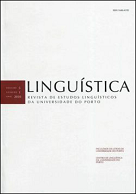Suffix classes in English and Portuguese: foundations and repercussions
Abstract
“Dual membership suffixes” represent a crucial structuring framework of English morphology with undeniable consequences within language’s lexical processement. This text aims to analyse some of the major results of recent research carried out on the criteria underlying this dichotomy, and to discuss if they can be applied to Portuguese suffixes, and under what conditions. Morphological and prosodic properties are convoked, as well as other idiosyncratic features of the suffixes and of the bases that are (pycho)linguisticaly relevant when they are selected by native Portuguese speakers.
References
Aronoff, M. 1976. Word Formation in Generative Grammar. Massachusetts: The MIT Press.
Bilysnka, O. 2007. Romance suffix rivalry of action nouns from middle English verbs in the OE textual prototypes. Studia Anglica Resoviensia 4: 25-32.
Bisol, L. 2000. O troqueu silábico no sistema fonológico (Um Adendo ao Artigo de Plínio Barbosa). D.E.L.T.A. 16 (2): 403-413.
Caplan, D. 1992. Language: Structure, processing, and disorders. Cambridge, MA.: The MIT Press.
Cho, H. M. 2007. Level 1 and Level 2 Affixes in English: Morphological Productivity and SemanticPhonological Transparency. Modern English Education 8(2): 40- 58.
Festas, I.; Leitão, J.; Formosinho, M.D.; Albuquerque, A.; Martins, C. et al. 2006. Uma bateria de avaliação psicolinguística das afasias e de outras perturbações da linguagem para a população portuguesa. In: C. Machado, L. Almeida, A. Guisande, M. Gonçalves, & V. Ramalho (Orgs.), Actas da XI Conferência Internacional “Avaliação Psicológica: Formas e Contextos”. Braga: Psiquilibrios: 719-729.
Jarmulowicz, L. D., 2002. English Derivational Suffix Frequency and Children’s Stress Judgments. Brain and Language 81: 192-204.
Jarmulowicz, L. D., 2006. School-Aged Children’s Phonological Production of Derived English Words. Journal of Speech and Hearing Disorders 49: 294-308.
Kiparsky, P. 1982. Lexical Phonology and Morphology. Linguistics in the Morning Calm. The Linguistics Society of Korea, ed.. Seoul: Hanshin Publishing Co.: 3- 91.
Liberman, M.; Prince, A. 1977. On Stress and Linguistic Rhythm. Linguistic Inquiry 8: 249-336.
Martins, C.; Rio-Torto, G.; Festas, I. 2010. Processamento de palavras sufixadas. Desafios da adaptação à língua portuguesa de provas morfológicas da bateria PAL (Psycholinguistic Assessment of Language). Comunicação apresentada [secção 4] no 26º Congresso Internacional de Linguística e Filologia Românicas (Valência, 6-11 de Setembro de 2010).
Pereira, I. 1996-1997. O acento de palavra em português: algumas considerações. Revista Portuguesa de Filologia XXI: 265-285.
Pereira, I. 1999. O acento de palavra em português. Uma análise métrica. Dissertação de Doutoramento. Universidade de Coimbra.
Piel, J. 1942. O património visigótico na língua portugesa. Coimbra: Instituto Alemão da Universidade.
Rio-Torto, G. 1993. Formação de palavras em português. Aspectos da construção de avaliativos. Dissertação de Doutoramento: Universidade de Coimbra.
Rio-Torto, G. 1999-2000. Configurações sufixais e -z-sufixais em português. Revista Portuguesa de Filologia XXIII: 151-182.
Rio-Torto, G. 2002. Flexão e derivação: simetrias e assimetrias. Revista Portuguesa de Filologia XXIV: 253-289.
Siegel, D. (1974), Topics in English Morphology. Massachusetts: The MIT Press.
Seung-Hwa, L. 2006. Teoria da Otimalidade e mudança lingüística - evolução do acento do português. SCRIPTA, Belo Horizonte 9(18): 45-61.
Vannest, J.; Polk, T. A.; Lewis, R. L. 2005. Dual-route processing of complex words: new fMRI evidence from derivational suffixation. Cognitive, Affective, and Behavioral Neuroscience 5: 67-76.
Downloads
Published
Issue
Section
License
Copyright (c) 2017 Linguística Revista de Estudos Linguísticos da Universidade do Porto

This work is licensed under a Creative Commons Attribution-NonCommercial 4.0 International License.



